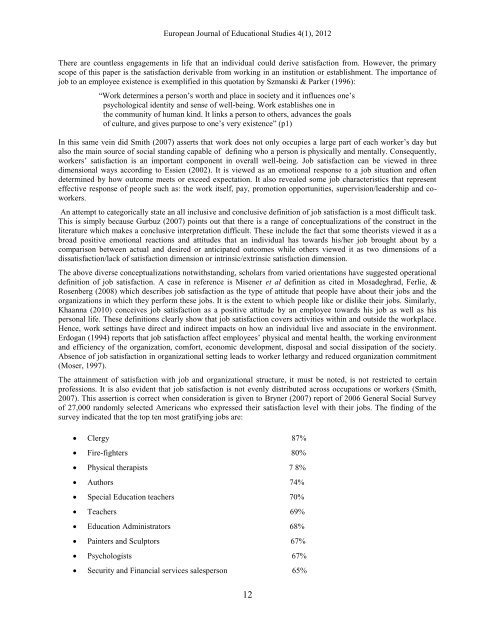Volume 4 Issue 1 (February 2012) - Ozean Publications
Volume 4 Issue 1 (February 2012) - Ozean Publications
Volume 4 Issue 1 (February 2012) - Ozean Publications
Create successful ePaper yourself
Turn your PDF publications into a flip-book with our unique Google optimized e-Paper software.
European Journal of Educational Studies 4(1), <strong>2012</strong><br />
There are countless engagements in life that an individual could derive satisfaction from. However, the primary<br />
scope of this paper is the satisfaction derivable from working in an institution or establishment. The importance of<br />
job to an employee existence is exemplified in this quotation by Szmanski & Parker (1996):<br />
“Work determines a person‟s worth and place in society and it influences one‟s<br />
psychological identity and sense of well-being. Work establishes one in<br />
the community of human kind. It links a person to others, advances the goals<br />
of culture, and gives purpose to one‟s very existence” (p1)<br />
In this same vein did Smith (2007) asserts that work does not only occupies a large part of each worker‟s day but<br />
also the main source of social standing capable of defining who a person is physically and mentally. Consequently,<br />
workers‟ satisfaction is an important component in overall well-being. Job satisfaction can be viewed in three<br />
dimensional ways according to Essien (2002). It is viewed as an emotional response to a job situation and often<br />
determined by how outcome meets or exceed expectation. It also revealed some job characteristics that represent<br />
effective response of people such as: the work itself, pay, promotion opportunities, supervision/leadership and coworkers.<br />
An attempt to categorically state an all inclusive and conclusive definition of job satisfaction is a most difficult task.<br />
This is simply because Gurbuz (2007) points out that there is a range of conceptualizations of the construct in the<br />
literature which makes a conclusive interpretation difficult. These include the fact that some theorists viewed it as a<br />
broad positive emotional reactions and attitudes that an individual has towards his/her job brought about by a<br />
comparison between actual and desired or anticipated outcomes while others viewed it as two dimensions of a<br />
dissatisfaction/lack of satisfaction dimension or intrinsic/extrinsic satisfaction dimension.<br />
The above diverse conceptualizations notwithstanding, scholars from varied orientations have suggested operational<br />
definition of job satisfaction. A case in reference is Misener et al definition as cited in Mosadeghrad, Ferlie, &<br />
Rosenberg (2008) which describes job satisfaction as the type of attitude that people have about their jobs and the<br />
organizations in which they perform these jobs. It is the extent to which people like or dislike their jobs. Similarly,<br />
Khaanna (2010) conceives job satisfaction as a positive attitude by an employee towards his job as well as his<br />
personal life. These definitions clearly show that job satisfaction covers activities within and outside the workplace.<br />
Hence, work settings have direct and indirect impacts on how an individual live and associate in the environment.<br />
Erdogan (1994) reports that job satisfaction affect employees‟ physical and mental health, the working environment<br />
and efficiency of the organization, comfort, economic development, disposal and social dissipation of the society.<br />
Absence of job satisfaction in organizational setting leads to worker lethargy and reduced organization commitment<br />
(Moser, 1997).<br />
The attainment of satisfaction with job and organizational structure, it must be noted, is not restricted to certain<br />
professions. It is also evident that job satisfaction is not evenly distributed across occupations or workers (Smith,<br />
2007). This assertion is correct when consideration is given to Bryner (2007) report of 2006 General Social Survey<br />
of 27,000 randomly selected Americans who expressed their satisfaction level with their jobs. The finding of the<br />
survey indicated that the top ten most gratifying jobs are:<br />
Clergy 87%<br />
Fire-fighters 80%<br />
Physical therapists 7 8%<br />
Authors 74%<br />
Special Education teachers 70%<br />
Teachers 69%<br />
Education Administrators 68%<br />
Painters and Sculptors 67%<br />
Psychologists 67%<br />
Security and Financial services salesperson 65%<br />
12

















